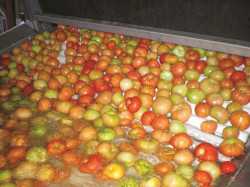Getting Educated On FSMA Regulations

It Isn’t here today but it is inevitable. From the starter’s gun on Jan. 4, 2011, with the signing of the Food Safety Modernization Act (FSMA), the FDA Produce Safety Rule is grinding its way toward release for public comment.
While FDA leadership responsible for the draft Produce Rule has been very visible in public meetings to discuss focus, objectives, strategy, and scope of implementation, it has been handcuffed to give specifics. Delayed in review by the Office of Management and Budget, FDA can only share some limited, but essential, insight into where their deliberative and consultative process has landed.
For many mid- and small-scale growers wanting or needing to move proactively toward an initial or improved on-farm food safety plan, the uncertainty of what will be required and regulated under the Produce Rule has handcuffed their actions, as well. Everything from commodity criteria to a litany of other components become critical decision factors bearing economic consequences.
Whether GAP-certified or non-certified, conventional or organic, included or provisionally exempted in the current scope of FSMA, it is very hard to determine your route if you don’t have a roadmap. However, that is where we are, so let’s follow the advice of Yogi Berra: “When you come to a fork in the road…take it.”
The Focus Of Food Safety
So let’s briefly review highlights of what we do know.
1. FSMA and the pending Produce Safety Rule focuses on preventive controls.
2. FDA is charged with developing and enforcing science-based minimum standards for the safe production and harvesting of produce where it is determined that such standards minimize the risk.
3. The draft Produce Safety rule will not rely or be solely based on commodity risk ranking strategies. Much of the emphasis highlights broader practices that are largely region, scale, crop, and crop management style independent.
4. The focus is on prevention and traceability from production to distribution.
5. The Produce Safety Rule will incorporate the following imperatives: a one-size approach is not reasonable; the standards must be mindful of environmental and water quality management goals; the standards should not prevent compliance with other federal programs.
6. Each operation will be expected to identify site-specific hazards, establish prevention controls, monitor the effectiveness of the controls, take corrective action if controls fail, verify effectiveness of corrective measures, and document and maintain records of all of the above.
7. The Produce Rule will include fruits and vegetables, sprouts, mushrooms,
peanuts, and tree nuts.
8. Commodities currently out-of-scope or exempt include rarely consumed raw (sweetpotatoes, potatoes, and artichokes), marketed after a validated kill-step, and single-farm direct marketing operations with gross income less than $500,000 and distributed within state or less than 275 miles from the farm. (Go to www.fda.gov/food/foodsafety/fsma/default.htm for more information.)
9. Education and implementation assistance is essential for small-scale, smaller family farms, and limited resource farming. The Produce Safety Alliance (PSA) at Cornell University, with broad stakeholder involvement, is moving toward a national training curriculum and centralized resource. PSA is also helping to prepare farms for proactive compliance and participation in public hearings and for the comment period once the draft Produce Rule is finally released (http://producesafetyalliance.cornell.edu/psa.html).
10. Online tools, such as http://onfarmfoodsafety.org are available to help operations get an easy jump-start into developing a farm-specific manual with templates and checklists that USDA has acknowledged will satisfy a basic farm-audit toward getting certified.
Get Educated
One of the key steps to take right now is to become informed about microbial hazards and routes of contamination.
In wrapping up this column, I would like to share this closing thought built on more than 20 years of produce industry and university Extension exposure and experience. In many of the outbreak and recall investigations, it was apparent that there was a moment in time for someone directly involved in the operation to recognize a microbial hazard and make a prevention or control-point decision that would likely have averted or greatly reduced public risk and consequences to individual growers, a commodity, a region, and consumers.
For additional post-harvest questions, go to page two.
Postharvest Questions
Over the next several columns, I will focus on postharvest questions related to produce safety compliance, whether customer-driven or regulatory, and a best effort to answer with practical science-based information. I’ll start with this one:
What are the two areas of compliance in postharvest operations you anticipate will be hardest to meet?
1. Small scale grower/shippers will likely be frustrated by the substantial gap that will (and is) emerging due to increasing audits and inspections as to what is an acceptable and unacceptable facility design and conditions. Historical acceptance of “rough” washing and packing conditions for raw agricultural commodities (whole fruits and vegetables) will become extinct. Few would seriously expect to apply a “white-glove inspection” standard to the majority of situations and a healthy dose of common sense can and should be applied. However, the bar needs to be and is being raised. Where that threshold standard for packing facility and equipment design, management, and monitoring should be set is neither clear nor straightforward.
2. Postharvest water quality management to 1) prevent
cross-contamination; 2) reduce surface contamination; and 3) prevent infiltration remains a challenging area with a solid-science foundation but several key knowledge gaps, particularly for
small-scale and limited resource farms.










